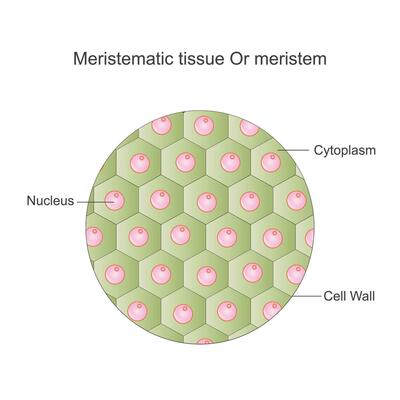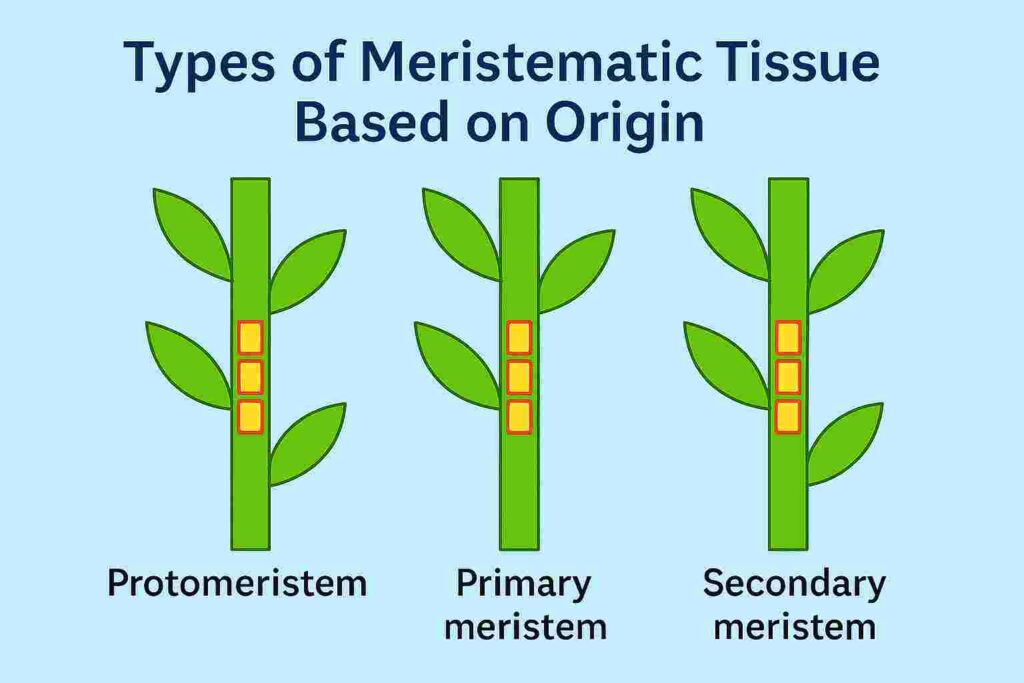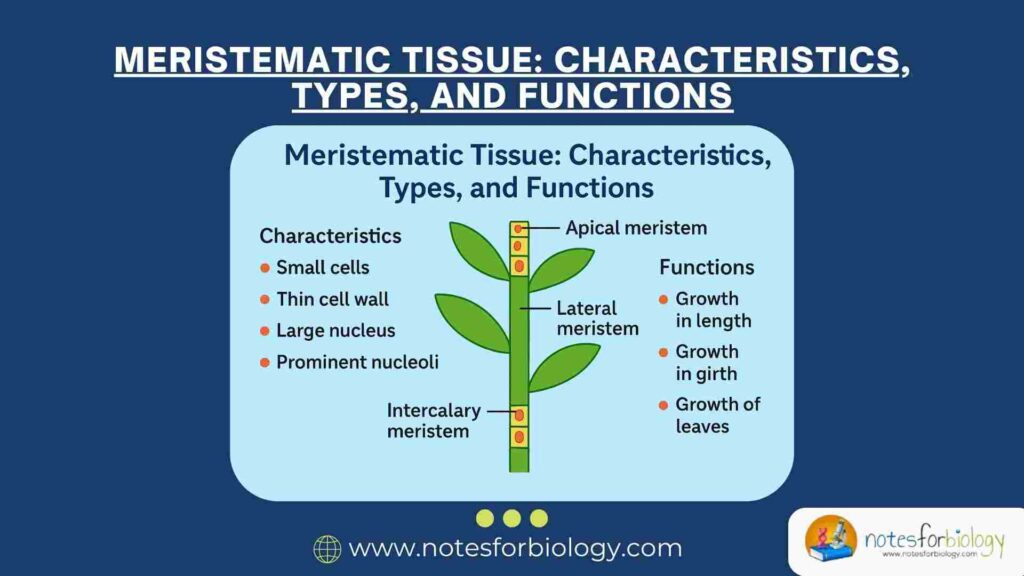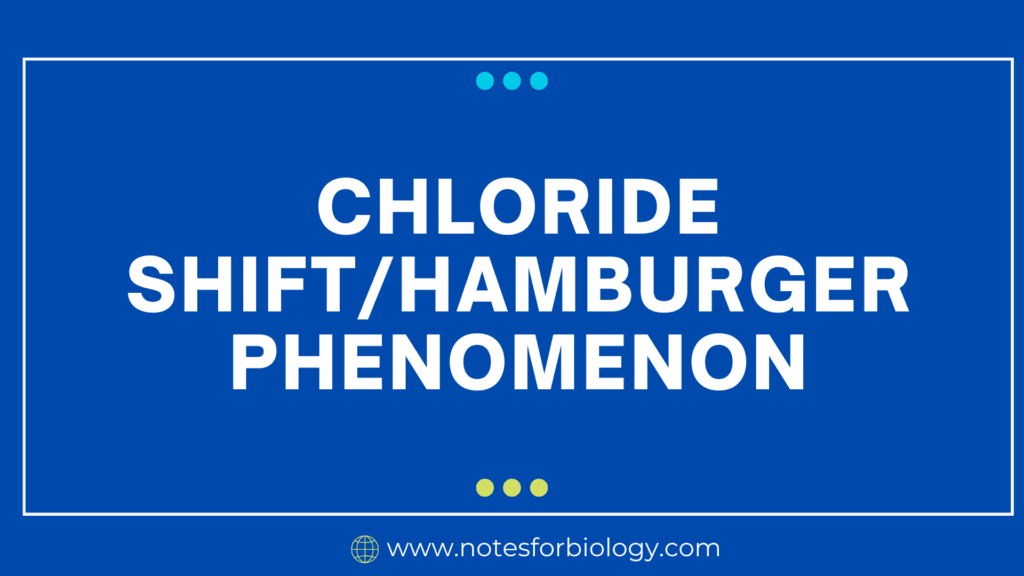Plants, unlike animals, continue to grow throughout their life due to the presence of specialized tissues known as meristematic tissues. These tissues are composed of actively dividing, undifferentiated cells that possess the capability to form new tissues and organs. Meristematic tissues are primarily responsible for the growth and development of a plant body, enabling both primary and secondary growth. They ensure the formation of new cells for elongation, thickening, and regeneration, making them indispensable for the plant’s survival and adaptation.
This content offers a comprehensive explanation of meristematic tissue, elaborating on its characteristics, classification, and various functions in plant life.
Summary of Meristematic Tissue
- Meristematic tissue consists of actively dividing, immature plant cells that are responsible for continuous growth, enabling the plant to increase in length, thickness, and regenerate lost parts.
- It is classified based on position (apical, intercalary, lateral) and origin (protoderm, procambium, ground meristem), with each type playing a specific role in primary growth, secondary growth, and tissue differentiation.
- Meristematic tissues are essential for forming new organs, repairing injuries, and regulating the overall shape and form of plants, ensuring survival, reproduction, and adaptation to environmental conditions.
Table of Contents
Definition of Meristematic Tissue

Meristematic tissue is a group of immature, undifferentiated plant cells that possess the ability to divide continuously by mitosis, leading to the formation of new cells. These cells are densely packed, have thin cell walls, large nuclei, and lack intercellular spaces. They play a fundamental role in the growth processes of plants by contributing to the formation of permanent tissues and new plant organs.
Location of Meristematic Tissue

Meristematic tissues are found in specific regions of a plant where active cell division takes place. These locations are directly associated with plant growth in length, girth, and the formation of new organs. Based on their position in the plant body, meristematic tissues are categorized into three main types:
Apical Meristem
Location:
Apical meristems are located at the tips of roots and shoots.
Function:
They are responsible for primary growth, which increases the length of the plant. This enables the plant to grow upwards and downwards, forming new leaves, flowers, and branches at the growing tips.
Lateral Meristem
Location:
Lateral meristems are found along the sides of stems and roots, usually in the form of vascular cambium and cork cambium (phellogen).
Function:
They are responsible for secondary growth, increasing the thickness or girth of stems and roots, especially in woody plants.
Intercalary Meristem
Location:
Intercalary meristems are located between mature permanent tissues, usually at the base of leaves, nodes, or internodes in certain plants like grasses and bamboos.
Function:
They help in the elongation of internodes and rapid growth in specific parts of the plant, especially after grazing or cutting.
Characteristics of Meristematic Tissue
Meristematic tissue exhibits a range of structural and physiological features that distinguish it from other plant tissues. These features are directly linked to the tissue’s primary role in growth through active cell division.
Actively Dividing Cells
The cells within meristematic tissue exhibit active mitotic divisions, continually producing new cells. This activity makes them essential for plant growth, both in length and girth. The division potential of these cells diminishes only when they mature and differentiate into permanent tissues.
Thin Cell Walls
Meristematic cells possess thin and elastic primary cell walls made predominantly of cellulose. The thinness of the wall allows for efficient exchange of water and nutrients necessary for rapid cell division and metabolic activities.
Dense Cytoplasm
These cells contain abundant, dense cytoplasm which supports the high metabolic activity required for continuous cell division. The cytoplasm houses numerous cellular organelles actively involved in growth processes.
Prominent Nuclei
Each meristematic cell contains a large, prominent nucleus. The presence of such a nucleus facilitates the regulation of cellular activities and controls the process of mitotic cell division.
Absence of Vacuoles
In meristematic tissue, vacuoles are either absent or very small. This absence provides more cytoplasmic space for cellular machinery associated with cell division, making these cells highly efficient in producing new cells.
Lack of Intercellular Spaces
The cells are tightly packed with no intercellular spaces between them. This compact arrangement ensures structural integrity and coordination during growth and division.
High Rate of Metabolism
Due to continuous cell division, meristematic tissues exhibit a high rate of metabolism. Their metabolic activities are regulated by plant hormones such as auxins and cytokinins, which influence cell division and differentiation.
Types of Meristematic Tissue Based on Position
The classification based on position in the plant body considers the location of meristematic tissues and their contributions to different aspects of growth.
Apical Meristem
Apical meristem is located at the tips of roots, stems, and branches. It is primarily responsible for the elongation of plant organs, contributing to primary growth. This meristematic tissue facilitates the formation of new leaves, flowers, and branches by continuously producing new cells. It enables the plant to grow in height and extend its roots deeper into the soil.
Intercalary Meristem
Intercalary meristem is found between mature tissues, typically at the base of leaves, internodes, and nodes in certain plants such as grasses and monocots. This meristem assists in the elongation of specific plant parts, particularly in regions where active growth is temporarily halted and then resumed. It plays a significant role in regenerative growth, enabling plants to quickly recover from grazing, cutting, or environmental damage.
Lateral Meristem
Lateral meristem is situated along the sides of stems and roots. It contributes to the plant’s secondary growth, which involves an increase in thickness or girth. The two main types of lateral meristem are the vascular cambium and cork cambium. The vascular cambium produces secondary xylem and secondary phloem, while the cork cambium generates protective layers of cork to replace the epidermis in older stems and roots.
Types of Meristematic Tissue Based on Origin

When classified by their origin, meristematic tissues are identified according to their derivation from the embryonic meristem and the specific plant structures they form.
Protoderm
Protoderm is the outermost layer of meristematic cells originating from the embryonic meristem. It gives rise to the epidermis, the plant’s outer protective covering, which serves as a barrier against physical, chemical, and biological harm.
Procambium
The procambium originates from the embryonic meristem and is responsible for forming the vascular tissues. It differentiates into primary xylem and primary phloem, which are vital for the conduction of water, minerals, and nutrients throughout the plant body.
Ground Meristem
Ground meristem is derived from the embryonic meristem and produces the ground tissues of a plant, including parenchyma, collenchyma, and sclerenchyma. These tissues perform various functions such as photosynthesis, storage, and structural support.
Functions of Meristematic Tissue
Facilitating Growth
The primary function of meristematic tissue is to facilitate plant growth. By continuously dividing, these cells produce new tissues and organs that enable the plant to grow in both height (primary growth) and thickness (secondary growth). The apical meristem contributes to elongation, while lateral meristem promotes thickening of plant parts.
Formation of Permanent Tissues
Meristematic tissue generates new cells, which later differentiate into permanent tissues such as parenchyma, collenchyma, sclerenchyma, xylem, and phloem. This process of differentiation allows the plant to develop specialized tissues adapted for specific functions like conduction, support, and storage.
Wound Healing and Regeneration
Meristematic tissues play an essential role in wound healing and regeneration in plants. When a plant experiences injury or physical damage, nearby meristematic cells become active, divide rapidly, and replace the lost or damaged tissues, ensuring recovery and continued growth.
Secondary Growth
The lateral meristem, particularly the vascular cambium and cork cambium, is responsible for secondary growth in dicotyledonous plants. This process increases the girth of stems and roots, producing additional layers of vascular tissues and protective cork to support the growing plant body.
Production of New Organs
Meristematic tissues enable the formation of new plant organs such as leaves, flowers, branches, and roots. The apical meristem produces new buds and shoots, while the intercalary meristem allows regeneration of leaves and internodes in monocots.
Regulation of Plant Shape
By controlling where and how much a plant grows, meristematic tissues contribute to the overall shape and form of the plant. Growth patterns influenced by the distribution and activity of meristematic tissues determine whether a plant exhibits bushy, tall, creeping, or climbing growth habits.
Significance of Meristematic Tissue
Meristematic tissues are groups of actively dividing cells found in specific regions of plants. These tissues play an essential role in the growth, development, and repair of plants. Their importance can be explained under several key headings:
Role in Plant Growth
Meristematic tissues are responsible for both primary and secondary growth in plants. Apical meristems at the tips of roots and shoots increase the plant’s length, while lateral meristems like vascular cambium and cork cambium increase the thickness of stems and roots.
Formation of New Organs
These tissues continuously produce new cells, which later differentiate into various tissues and organs such as leaves, flowers, fruits, and branches. This ensures the development and reproduction of the plant throughout its life.
Wound Healing and Tissue Repair
When a plant is injured, meristematic cells near the damaged area divide rapidly to form new cells. This helps in sealing wounds, healing damaged parts, and regenerating lost tissues, maintaining the plant’s health and structure.
Contribution to Secondary Growth
Lateral meristems such as the vascular cambium and cork cambium contribute to secondary growth, which increases the girth and strength of woody plants. This allows trees and shrubs to become stronger and live for many years.
Importance in Plant Biotechnology
Meristematic tissues are vital in plant tissue culture and micropropagation techniques. Since they are free from infections and actively dividing, they are ideal for producing large numbers of identical, disease-free plants and conserving rare plant species.
Evolutionary and Developmental Importance
Meristematic tissues help plants adapt and grow continuously in different environmental conditions by forming new tissues and organs. This feature is unique to plants and essential for their survival and evolutionary success.
Conclusion
Meristematic tissue is a vital component of plant anatomy, responsible for sustaining growth and enabling the formation of new tissues and organs. Its unique characteristics, including actively dividing cells, thin cell walls, dense cytoplasm, and absence of vacuoles, equip it to perform its functions efficiently. The classification of meristematic tissue based on position and origin highlights its diverse roles in primary and secondary growth, tissue formation, regeneration, and organ development. Understanding the structure, types, and functions of meristematic tissue provides deeper insights into plant growth dynamics and adaptation strategies essential for survival in changing environments.
Overall, the study of meristematic tissue provides valuable insights into plant morphogenesis, adaptability, and survival mechanisms. It forms a crucial aspect of plant anatomy and physiology, offering foundational knowledge for fields such as botany, agriculture, and horticulture. Understanding the behavior, types, and functions of meristematic tissue is essential not only for academic study but also for practical applications in crop improvement, plant propagation, and biotechnology.
Frequently Asked Questions (FAQ)
What is meristematic tissue?
Meristematic tissue is a group of actively dividing, undifferentiated plant cells responsible for growth and the formation of new tissues and organs.
What are meristems and their functions?
Meristems are regions of meristematic tissue found at specific locations in plants. Their main functions are to produce new cells for growth, enable elongation (primary growth), increase thickness (secondary growth), and repair damaged tissues.
What is the structure of the meristem?
Meristematic tissue consists of small, densely packed cells with thin cell walls, large nuclei, dense cytoplasm, and little or no vacuoles, allowing them to divide rapidly.
Related Contents
Bacteroides: Classification, virulence factors and biochemical tests
Bacterial Spore: Structure, Types, Sporulation and Germination




